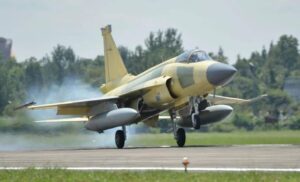In today’s fast-moving world, technological advancements seem to affect all aspects of traditional and non-traditional security challenges. In this context, military modernization programs are considered to be the main driver that sets the direction to overcome these multidimensional security threats. Modern states are trying to adopt technological innovations to utilize them in military and battlefield dominance, which has created an imbalance of power and has further intensified strategic competition in the region. These disruptive technologies and strategies are true without any doubt a game-changer not just in warfare but also in geopolitics and diplomacy.
Powerful armies are modernizing their existing conventional and non-conventional military technology and weaponry systems to cope with emerging threats, challenges, and competition. This also includes the induction of new and advanced nuclear programs with modern delivery systems that may be portable, meaning very small in size. Cyber security tech is also considered to be a key part of national security today. Nonetheless, countries are investing heavily in military modernization programs as much as they can. South Asia seems to be no exception, our neighbor India is heavily investing in the modernization of their conventional weapons and programs.
Does military modernization reduce defense spending?
The new technology-based military competition has become a major security challenge for the world. According to a SIPRI report, the US, despite having the largest defense expenditure in the world, had a net decrease in their military spending, while other countries had a 2 to 3 percent increase. The reason behind this phenomenon is that now the US focuses on military modernization and innovative technology such as weaponizing artificial intelligence rather than spending money on conventional weapons. Emerging technologies and innovations in military weaponry systems have curtailed military spending. The future seems to be infested with technology-based solutions even in traditional security threats and challenges.
National Security Policy of Pakistan and threat assessment:
According to former Ambassador Aizaz Ahmed Chaudhry, the national security policy of Pakistan is based on three tenets. Economic security, human security, and traditional security make it a comprehensive national security policy. In standard procedures, threat assessment is the first step that a state takes in order to formulate national security. If an accurate threat assessment is conducted specific to your country’s interests, we will be able to devise a good national security policy. This strategy should be applied by Pakistan as well, to correspond with that assessment and new challenges that are related to the rising technological arms race in the region and the world as a whole.
Technological optimization and Pakistan armed forces:
Every great power is compelled to adopt new military technology and upgrade its traditional policy framework hence it is imperative for Pakistan to cope up with the modern trends in military and warfare strategies. According to former Joint Chief of Staff Committee General Zubair Mehmood Hayat, technological optimization in national defense has changed the dynamics and character of war and modern battlefields. The use of technology in military matters gives you an asymmetrical advantage. It means a small power can utilize the use of technology in their desired priorities with cutting-edge and specific fields that can compete against a much more powerful force. Pakistan army fits perfectly with this strategy of competing with much more powerful rival forces despite having such limited resources.
Induction of VT-4 in Armored Corps:
The induction of Chinese-manufactured VT-4 tanks in the Pakistan army is one of many initiatives of technological optimization and military modernization. Pakistan became the third country to induct these Chinese tanks after Thailand and Nigeria.

According to ISPR, the VT-4 tank is interoperable with any current modern tank in the world. It comprises advanced armor protection, extensive firepower capabilities, quick maneuverability, and state-of-the-art technology. According to Pakistan Army VT-4 tanks are third-generation tanks that will be utilized in an offensive role in strike formation.
Pakistan Navy’s PNS Tughril Frigate:
PNS Tughril, Type 054A/P is also a Chinese engineered frigate designed by China State Shipbuilding Corporation Limited. The frigate contains a new combat management system and is said to be technologically superior to all the frigates the Pakistan navy has. The construction of four PNS Tughril frigates for the Pakistan Navy was part of a 2017 agreement. It is equipped with modern sensors, SR2410C long range, and Type 517/SUR17B Air-Surveillance radars. PNS Tughril comprises stealth capabilities such as sloped hull design and radar absorbent materials. Other modern weapon systems include HQ-16 medium-range air defense missiles which reach up to 50 km. Anti-aircraft missiles, anti-ship cruise missiles with vertical launching systems. Other capabilities include eight C-802 land attack cruise missiles, one PK26 76mm naval gun, type 1130, two types 703 7-barrel guns, Yu-7 ASW torpedo launchers, two anti-submarine rocket launchers, and 18 tube decoy rocket launchers.
The frigate contains four Shaanxi 16 PA6 STC diesel engines, each engine develops 5700 kW. The frigate is capable of carrying a total of 165 people and can go up to a top speed of 27 knots with a cruising range of 9025 nautical miles according to a report.
JF-17 Thunder Block III:
JF-17 Thunder is the best example of a modern yet low-budget multirole fighter aircraft. The JF-17 Thunder contains all the modern tech and capabilities. The aircraft can easily integrate a variety of air-to-air and air-to-ground weapons systems. It comprises active radar air-to-air missiles and is capable of launching cruise missiles. The Block 3 variant which is being developed is a stealth aircraft that will be operational in the near future. Its first flight was in Dec 2019. It is expected to serve before 2023 according to experts. JF-17 Block 3 is expected to revolutionize the capabilities of PAF. Its new avionics suite including its controls and cockpit display seems quite similar to the modern J-10 aircraft.

JF-17’s helmet-mounted sights and heads-up displays are ahead of those of early 5th Generation fighter jets. It also allows the aircraft to deploy a set of a new range of armaments. Other modern capabilities Block 3 comprises are a powerful engine, a larger high composite airframe, a reduced radar cross-section, and an electronically scanned array radar. The materials and sensors that have been used in the aircraft are those which are needed to develop the 5th Generation of aircraft. The aircraft also contains new air-to-air missiles, the PL-15, and the PL-10 which will give a considerable advantage over many aircraft of PAF. Other modernized capabilities include its unmatchable maneuverability with a state-of-the-art helmet-mounted sighting system and infra-red guided air-to-air missiles.
Modernization in Air Defense:
To counter India’s Russian-made S-400 air defense system, the Pakistan army inducted the Chinese-made HQ-9 air defense system. According to reports, the HQ-9 comprises surface-to-air missiles that are capable of destroying aircraft, cruise missiles, and other airborne objects up to 100 km in a single strike. The HQ-9 system can easily be compared with the Russian S-400 in terms of capability.

The air defense system has a strategic long-range capability with extraordinary precision and adaptability. According to experts, HQ-9 can easily cover the whole region of Indian Occupied Jammu and Kashmir. It also has the capability to protect the strategic coastal areas of Pakistan.
Drone Technology of Pakistan:
Pakistan has invested significantly in drones. Just like in missile technology, Pakistan has gained quite a name in drone tech which is being used in Pakistan Army and Navy. Surveillance drones such as Scan Eagle and Uqab are in service with the Pakistan Navy already. Pakistan’s combat drone includes Burraq which has been used against targeting Tehreek e Taliban Pakistan hideouts in Waziristan. Another indigenous tactical drone produced by Pakistan is the Shahpar and Shahpar 2. Shahpar can cruise at 150 km and has seven hours of operational endurance. Shahpar 2 is a medium altitude long endurance drone with an endurance of 14 hours and can operate at an altitude of 20000 ft. SATUMA Jasoos 2 is another indigenous drone of PAF. The main purpose of this drone is IRS and training. Pakistan has also acquired top-notch drones such as SELEX Galileo from Italy, CH-4 from China, and AAI RQ-7 Shadow from America.
Is military modernization the future?
Military modernization is no doubt the future of warfare and battlefields. Modern warfare has been greatly affected by technological advancements in defense and weaponry systems over the years. Technology has brought about revolutionary changes in the character of war as General Zubair Mehmood Hayat puts it. But at the same time, the character, resilience, and morale of a soldier in an individual capacity cannot be ignored as it is also something that has an enormous effect on the nature of warfare and its outcome. Pakistan is one of those countries which has the highest number of infantry soldiers in the army but its pursuit of adopting modernization and technological advancements in its armed forces will create a perfect and unbreakable combination of man and machine.
Author: Muhammad Asim Khan










